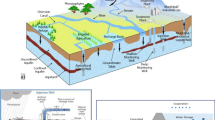Abstract
Saltwater intrusion is a widespread contamination problem of continuing great practical interest in many coastal and inland aquifers all over the world. Therefore, it is highly desirable to properly manage groundwater resources for drinking-water supply by controlling saltwater intrusion. This paper proposes to provide two recommendations of controlling saltwater intrusion in an inland aquifer for drinking-water supply at a certain waterworks site in Berlin (Germany) on the basis of the validated source of saltwater intrusion as well as pumping optimization, using a density-dependent groundwater flow and solute transport model. In terms of pumping-rate reduction, the optimal pumping rate was validated for eliminating the effect of saltwater intrusion. Without consideration of scenario conditions, its value could be set 1.39 × 10−2 m3/s (50 m3/h) or 5.56 × 10−3 m3/s (20 m3/h), if the requirement of drinking water palatability were good or excellent, respectively. With regard to pumping-pattern rearrangement, the well construction was modified to access bank filtration for eliminating the effect of saltwater intrusion.





Similar content being viewed by others
References
Abarca E, Vazquez-Sune E, Carrera J, Capino B, Gamez D, Batlle F (2006) Optimal design of measures to correct seawater intrusion. Water Resour Res 42, W09415. doi:10.1029/2005wr004524
Abd-Elhamid HF, Javadi AA (2011) A cost-effective method to control seawater intrusion in coastal aquifers. Water Resour Manag 25:2755–2780. doi:10.1007/s11269-011-9837-7
Bear J (1972) Dynamics of fluids in porous media. American Elsevier, New York
Bobba AG (1993) Mathematical models for saltwater intrusion in coastal aquifers. Water Resour Manag 7:3–37. doi:10.1007/BF00872240
Cai J, Taute T, Hamann E, Schneider M (2015) An integrated laboratory method to measure and verify directional hydraulic conductivity in fine-to-medium sandy sediments. Ground Water 53:140–150. doi:10.1111/gwat.12156
Cai J, Taute T, Schneider M (2014) Saltwater upconing below a pumping well in an inland aquifer: a theoretical modeling study on testing different scenarios of deep saline-groundwater pathways. Water Air Soil Pollut 225:1–11. doi:10.1007/s11270-014-2203-7
Cheng AHD, Halhal D, Naji A, Ouazar D (2000) Pumping optimization in saltwater-intruded coastal aquifers. Water Resour Res 36:2155–2165. doi:10.1029/2000wr900149
Das A, Datta B (1999a) Development of management models for sustainable use of coastal aquifers. J Irrig Drain Eng 125:112–121. doi:10.1061/(Asce)0733-9437(1999)125:3(112)
Das A, Datta B (1999b) Development of multiobjective management models for coastal aquifers. J Water Resour Plan 125:76–87. doi:10.1061/(Asce)0733-9496(1999)125:2(76)
El Moujabber M, Samra BB, Darwish T, Atallah T (2006) Comparison of different indicators for groundwater contamination by seawater intrusion on the Lebanese coast. Water Resour Manag 20:161–180. doi:10.1007/s11269-006-7376-4
Emch PG, Yeh WWG (1998) Management model for conjunctive use of coastal surface water and ground water. J Water Resour Plan 124:129–139. doi:10.1061/(Asce)0733-9496(1998)124:3129)
Freeze RA, Cherry JA (1979) Groundwater. Prentice-Hall, Inc., Englewood Cliffs
Finney BA, Samsuhadi, Willis R (1992) Quasi-3-dimensional optimization model of Jakarta Basin. J Water Resour Plan 118:18–31. doi:10.1061/(Asce)0733-9496(1992)118:1(18)
Garabedian SP (2013) Estimation of saltwater upconing using a steady-state solution for partial completion of a pumped well. Ground Water 51:927–934
Gordon E, Shamir U, Bensabat J (2000) Optimal management of a regional aquifer under salinization conditions. Water Resour Res 36:3193–3203. doi:10.1029/2000wr900177
Hallaji K, Yazicigil H (1996) Optimal management of a coastal aquifer in southern Turkey. J Water Resour Plan 122:233–244. doi:10.1061/(Asce)0733-9496(1996)122:4(233)
Huyakorn PS, Pinder GF (1983) Computational methods in subsurface flow. Academic, New York
Jakovovic D, Werner AD, Simmons CT (2011) Numerical modelling of saltwater up-coning: comparison with experimental laboratory observations. J Hydrol 402:261–273
Langevin CD, Thorne DT, Dausman AM, Sukop MC, Guo W (2007) SEAWAT Version 4: a computer program for simulation of multi-species solute and heat transport, U.S. Geological Survey Techniques of Water Resources Investigations Book 6, Chapter A22. U.S. Geological Survey, Reston, Virginia
Mantoglou A (2003) Pumping management of coastal aquifers using analytical models of saltwater intrusion. Water Resour Res 39:1335. doi:10.1029/2002WR001891
Mastrocicco M, Giambastiani BMS, Severi P, Colombani N (2012) The importance of data acquisition techniques in saltwater intrusion monitoring. Water Resour Manag 26:2851–2866. doi:10.1007/s11269-012-0052-y
Mohsen MS, Singh V, Amer A (1990) A note on saltwater intrusion in coastal aquifers. Water Resour Manag 4:123–134. doi:10.1007/BF00429801
Ségol G (1994) Classic groundwater simulations: proving and improving numerical models. Prentice-Hall, Inc, Englewood Cliffs
Servan-Camas B, Tsai FTC (2009) Saltwater intrusion modeling in heterogeneous confined aquifers using two-relaxation-time lattice Boltzmann method. Adv Water Resour 32:620–631. doi:10.1016/j.advwatres.2009.02.001
Singh A (2014) Optimization modelling for seawater intrusion management. J Hydrol 508:43–52
Singh A (2015) Managing the environmental problem of seawater intrusion in coastal aquifers through simulation-optimization modeling. Ecol Indic 48:498–504
Todd DK, Mays LW (2005) Groundwater hydrology, 3rd edn. Wiley, Hoboken
Hass U (2012) Analysis, occurrence, and fate of psychoactive compounds in an urban water cycle. Dissertation, Freie Universität Berlin
Zheng C, Bennett GD (2002) Applied contaminant transport modeling, 2nd edn. Wiley-Interscience, New York
Zhou X, Chen M, Liang C (2003) Optimal schemes of groundwater exploitation for prevention of seawater intrusion in the Leizhou Peninsula in southern China. Environ Geol 43:978–985. doi:10.1007/s00254-002-0722-9
Acknowledgments
We sincerely thank the associate editor and two anonymous reviewers for their constructive comments. The first author is sponsored by the ERASMUS MUNDUS External Cooperation Window Programme at Freie Universität Berlin (Project Lund, Lot 14a—China).
Author information
Authors and Affiliations
Corresponding author
Rights and permissions
About this article
Cite this article
Cai, J., Taute, T. & Schneider, M. Recommendations of Controlling Saltwater Intrusion in an Inland Aquifer for Drinking-Water Supply at a Certain Waterworks Site in Berlin (Germany). Water Resour Manage 29, 2221–2232 (2015). https://doi.org/10.1007/s11269-015-0937-7
Received:
Accepted:
Published:
Issue Date:
DOI: https://doi.org/10.1007/s11269-015-0937-7




